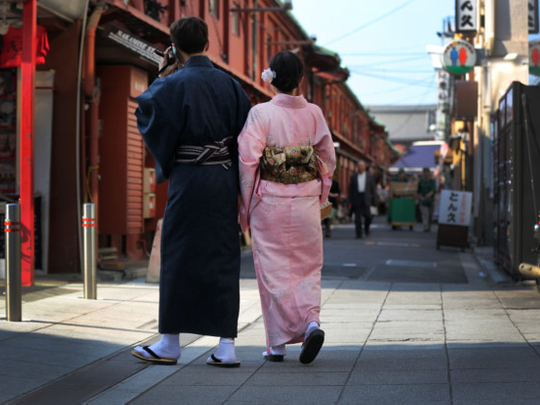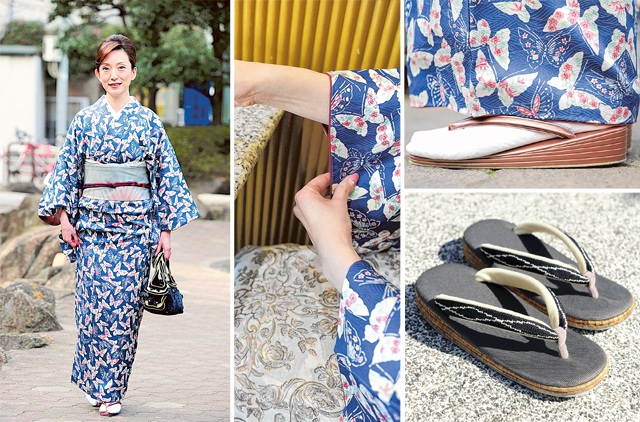
May is probably one of the best times of the year to go on outings. Heading out for a stroll in the season’s kimono with suitable accessories can help wearers better enjoy the season and entertain people who see them.
Although the kimono, a traditional Japanese garment, was a daily item in the past, few people wear them these days. Nevertheless, wearing kimono may help people who usually wear Western clothes see their daily life from a fresh perspective.
“If you are out about town in kimono, you can often attract the attention of other people. It can be nice,” said Satoko Kuroyanagi, a kimono adviser. “You also naturally look better when walking in kimono.”
There are various types of kimono, and the choice of wear differs depending on the occasion.
Kuroyanagi said kimono suited for a stroll in town is of a more casual type such as komon (with small, printed patterns running throughout), tsumugi (silk pongee), or cotton.
“If you wear kimono with patterns and colors suited for the part of town you visit, you look very cool and sophisticated,” Kuroyanagi said.
Kuroyanagi added she chooses a chic kimono when she goes to more mature, sophisticated areas of Tokyo such as Ginza and Nihonbashi.
“When you go to town where many young people are around, it may be fun to wear an antique kimono with remarkable patterns and colours,” Kuroyanagi said.
When you choose what kimono to wear, it’s also very important to consider the season.
“To represent spring, kimono with the patterns of cherry blossoms, butterflies and rapeseed flowers may be good,” Kuroyanagi said. “Yellow and bright green are suitable colours.”
I asked Kuroyanagi to show me some good combinations for going out on a stroll.
She chose a Yuki tsumugi (kimono using tsumugi textile mainly manufactured in Yuki, Ibaraki Prefecture, and its surrounding areas) in white and grey with a dark navy obi sash. The refreshing white is accentuating, creating a more mature feel.
Meanwhile, a blue kimono bearing the pattern of small butterflies has a light, brilliant appearance.
“Kimono in dark colours with patterns is suited for a stroll because even if it gets stained, it’s not noticeable,” Kuroyanagi said.
Walking in town entails descending and ascending slopes and stairs, and knowing how to wear kimono is greatly related to comfortable walking, particularly in adjusting the bottom part of a kimono.
Its length should not exceed the lower part of the heels. The bottom part should not wrap the legs too tightly.
Choosing zori sandals that are easy to walk in is also important. Those with thick straps prevent instep- and toe-aches, according to Kuroyanagi. Some zori shops offer services to adjust the length of the straps according to the size of the customers’ insteps.
I also asked Kuroyanagi about items convenient to take with you for a stroll.
“In case of rain, bringing an extra pair of tabi socks with you helps,” she said.
When you have a lot of things that cannot be contained in a bag meant for kimono, which is usually not very big, using bags for Western clothes that are suited to the colors and patterns of kimono is sufficient, she added.
Animal patterns, such as leopard or zebra, are suitable for plain-coloured kimono with no pattern. In summer, woven basket bags are recommended as they help create a cool and refreshing feel. However, bags with long handles or long shoulder straps are not suitable for kimono as they cannot be hung from the shoulders.
“Put on kimono and obi, and go out for a test walk to discover problems in how you dressed that need improvement, such as learning whether your obi is too loose or if it is in good shape,” she said.
Dressing up in kimono is one of the pleasures of dining when about town. Kuroyanagi suggests kimono wearers make efforts to eat elegantly, such as only taking small bites.
A large handkerchief is convenient for kimono wearers when dining. Spread it on your lap like a napkin to prevent your kimono from becoming soiled. When you pick something up from the table, prevent your sleeves from becoming stained by lightly holding back the lower part of the sleeve with your other hand.
“If you try to move elegantly that way, you can give off the impression to others that you are used to wearing kimono,” Kuroyanagi said.













